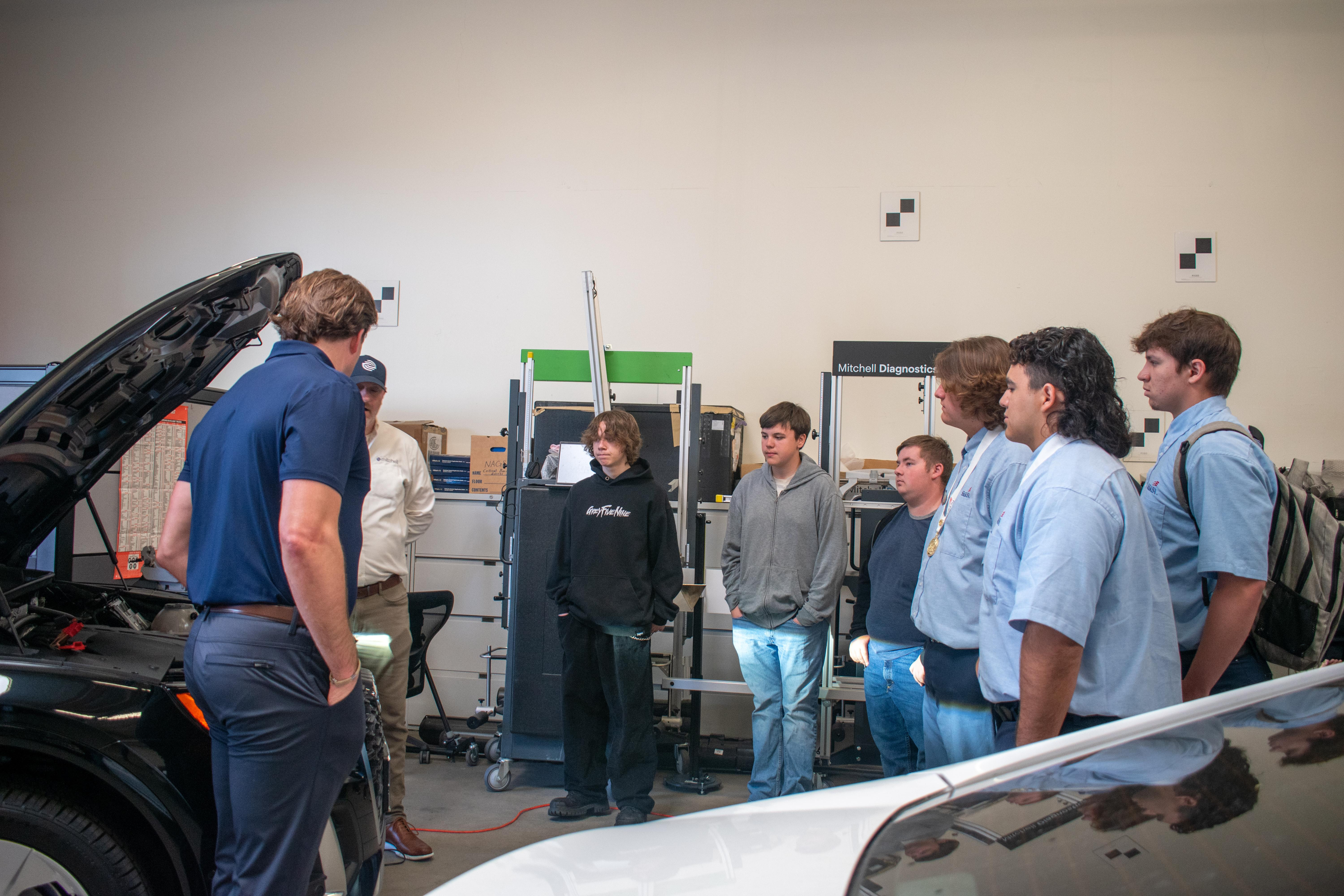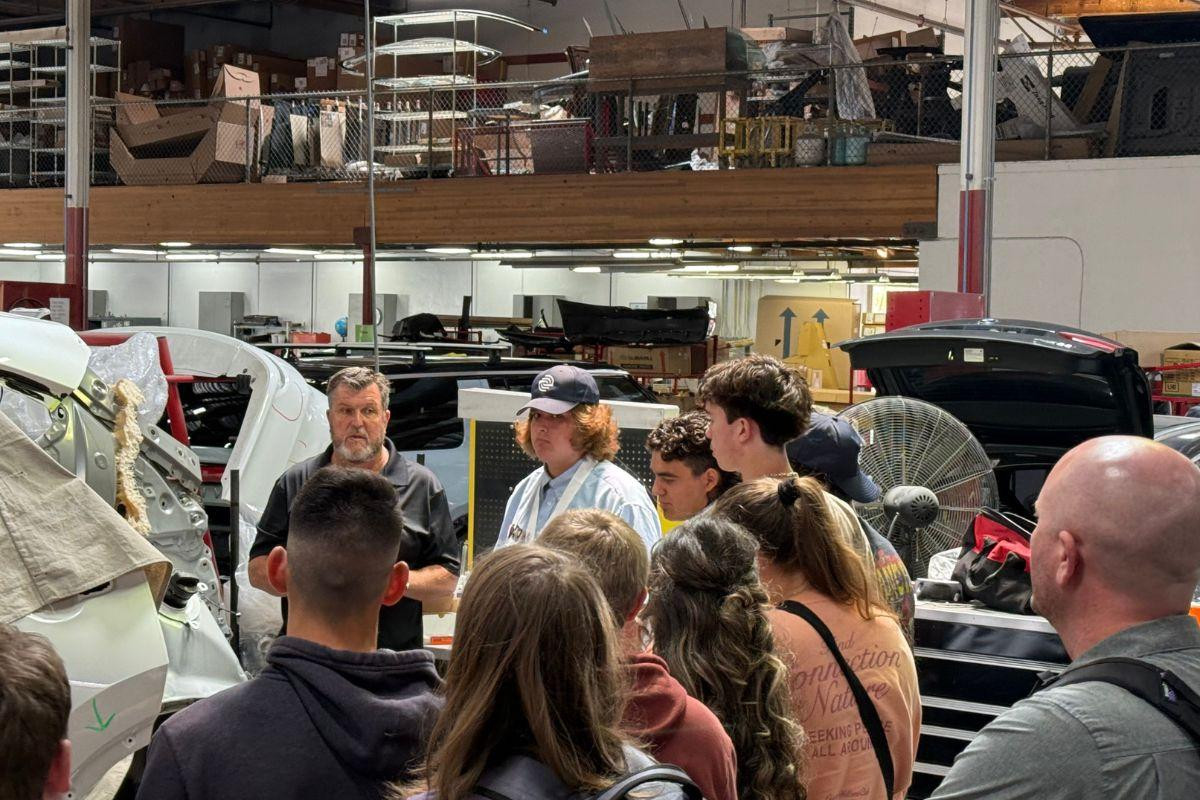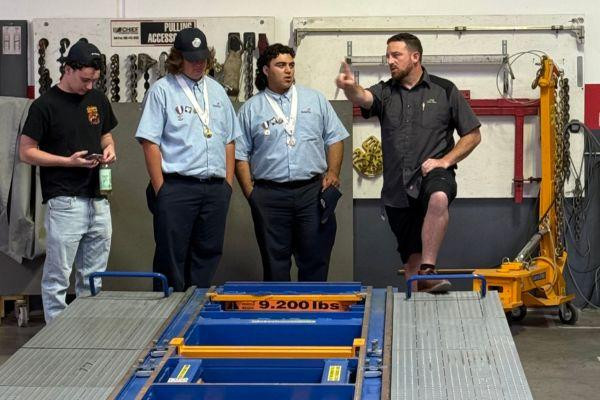Students from Santana High School’s auto body and computer science programs recently visited Mitchell’s Technical Research Center to learn about the innovative technology used to produce collision estimates, map vehicle parts and perform diagnostic scans and calibrations on automobiles equipped with Advanced Driver Assistance Systems (ADAS).
Students also got to see up close a Rivian R1T electric pickup, and visit Fix Auto Poway, a busy shop with multiple OEM certifications, for a look at the speed and complexity of the total repair process in real time.
The visit was the second time students from Santana High School in Santee, CA, visited the Mitchell center in nearby San Diego, as part of Mitchell’s ongoing efforts to address the technician shortage in collision repair by providing free access to some of the newest tools of the trade. The company also donates its products to automotive repair education programs around the country.
Nearly 30 students combined from the auto body and computer science programs attended.
Ben Sikora, auto body instructor, and Robert Pyle, engineering and computer science instructor, said the visit was a great way to expose students who are more into the hands-on aspects to the importance of the technological side, and the tech-savvy students to the hands-on side.
Pyle said the computer science students who attended were the ones who expressed interest. “There is some crossover between the two pathways already,” Pyle said. “They have learned about (computer aided design) CAD and processing data.”
 Students also saw a demonstration of how diagnostics tools generate calibration reports.
Students also saw a demonstration of how diagnostics tools generate calibration reports.
Students got to see how Mitchell creates 3D scans of vehicles to enable AI to generate preliminary estimates, by comparing photos of damaged areas to recorded parameters.
“It's really decreasing the cycle time on vehicles,” Sikora said. “In collision, we're always trying to do things faster.”
Students also saw a demonstration of how diagnostics tools generate calibration reports for modern vehicles equipped with ADAS features.
Luke Burger, solutions specialist for Mitchell, and Chase Hiller, a former Ford service technician who is now a diagnostic specialist for Mitchell, said systems supported by advanced technology have created a new career field in collision repair.
“It's a new area that the collision industry has to tackle now,” Hiller said. “But it's also another opportunity for employees.”
Sikora said visits like the one to Mitchell are crucial for his students, because the high school’s auto body program doesn’t get many vehicles with newer tech donated to work on.
“I need to teach these things [the students saw during the visit], but it's very hard to do if we're just sitting in a classroom talking theory,” he said. “Being able to see how these processes work live in person, it's a much better teaching tool than doing PowerPoint presentations.”
Sikora said Mitchell donated a diagnostics system to Santana High School’s auto body program in late 2023, along with a membership to its cloud-based estimating system.
 Gary Leger, far left, facing camera, owner of Fix Auto Poway, with students. Image courtesy of Fix Auto.
Gary Leger, far left, facing camera, owner of Fix Auto Poway, with students. Image courtesy of Fix Auto.
Jerry Gastineau, senior director of collision estimating databases for Mitchell, said the company is “privileged to be able to have access to a couple of communities that are attempting to build young minds into technicians. We support that 100%.”
He pointed to drivers’ growing reliance on ADAS features and other systems as they become more prevalent in new vehicles.
“Somebody's got to make sure that works properly,” Gastineau said. “We really need young, bright minds to come into the industry.”
Sikora said the visit to a working shop like Fix Auto Poway is also important so students see “the speed, the quality and the volume of vehicles. It's something that we can't really replicate inside the school. Everything takes us forever.”
Gary Leger is the owner of Fix Auto Poway, a 33,000-square-foot shop with OEM certifications that include Rivian, Tesla, VinFast and BMW.
 Auto body instructor Ben Sikora, far right, with three students during the visit to Fix Auto Poway.
Auto body instructor Ben Sikora, far right, with three students during the visit to Fix Auto Poway.
Leger said he “does everything I can” to support Santana High School’s auto body program by donating tools and speaking to students.
Hosting the students in his shop is another piece of that support. Leger said they saw “every aspect of the repair,” from drop-off of the vehicle by the customer to delivery. Students learned about coordinating with insurers, disassembly, writing estimates, ordering parts, refinishing and detailing -- “all the different careers you can have in a body shop.”
Leger praised Sikora, who took over the auto body program at the school when it was on the verge of being shuttered, following the retirement of its previous longtime instructor.
“He’s really a shining star,” Leger said. “I wish we could duplicate him throughout the county. He’s the guy who’s going to get these kids interested and let them know there’s a great career [in collision repair.]”
Leger said Sikora recently told him seeing two of his students win at the SkillsUSA California collision repair technology competition was “one of the proudest moments of his life.”
Ben Siekert won gold, while Abraham Espino won silver in the eight-hour competition, which included demonstrating their proficiency at dent repair, bumper repair, welding and damage analysis, and an interview.
Siekert, a junior at Santana High School who competed at the state level for the first time, is now headed to the national SkillsUSA competition in June in Atlanta.
He said he joined the auto body program at Santana his sophomore year to try it out, because he’d grown up helping his dad do routine maintenance on his vehicles.
“It's been a great class,” Siekert said. “I'm so happy I took it, because it's the only class where I can do hands-on work.”
He has enjoyed it so much, he plans to use the scholarship to UTI he won with his gold medal to continue his education after high school and pursue a career as a collision repair technician.
“I like the collision side, fixing things,” he said.














Abby Andrews